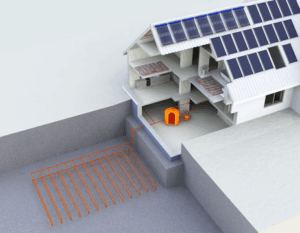How can I not be Net Zero? What exactly does Net Zero mean?
By some standards, you’re not Net Zero unless you generate as much power from renewable sources as you consume. For homeowners, that can be an extremely tough goal to match. Under that definition, you cannot be Net Zero unless you’re completely off the grid. That’s really not a viable option in some situations.
Discover how geothermal heating and cooling fits your needs.
The Oxford Dictionary defines net zero as: ”a target of completely negating the amount of greenhouse gases produced by human activity, to be achieved by reducing emissions and implementing methods of absorbing carbon dioxide from the atmosphere.” Carbon capture at home is just not a thing–at least not yet.
The government says this about Net Zero:
“ Achieving net-zero emissions means our economy either emits no greenhouse gas emissions or offsets its emissions, for example, through actions such as tree planting or employing technologies that can capture carbon before it is released into the air.”
That’s a little better, just plant some trees. But even so, unless you address what could be the largest carbon emitter in the home (the heating and cooling system), you may be offsetting, but you’re not reducing.
Why can’t I just go all electric?
That would certainly eliminate the burning of fossil fuels in your home, right? But would it? In British Columbia that would be true as Hydro is the main utility source of electricity. Here in Alberta, however, nearly 60% of our electricity generation comes from burning natural gas. Your all-electric heating and cooling system is still using fossil fuels, and since all-electric systems are less efficient than others, you wind up using more electricity than before.
Can I just use solar power?
Many suggest that a Net Zero home produces as much energy as it consumes. With the use of rooftop solar power, a homeowner can get close to Net Zero, but if natural gas is still a heating fuel, it’s a tougher case to make. The vast majority of home solar installations do not yield enough electricity to power a home all day every day. That is especially true for homes using traditional heating and cooling systems. Supplemental power comes from the grid in most cases, and in Alberta, that means natural gas-fueled power generation.
Okay, you’re so smart. How does one achieve Net Zero?
To be truly net zero, it’s important to look at the entire carbon footprint of your home, including what’s called embodied carbon. Embodied carbon refers to the amount of carbon emissions that resulted from the manufacture, transportation, and use of the materials that make up your home. Steel and concrete, for example, have a higher level of embodied carbon than wood.
The Net Zero home of today is constructed with low-carbon materials, and highly efficient systems and appliances. This makes it easier for the entire carbon footprint to be offset by the use of residential wind or solar power. The Net Zero home of today does not use fossil fuels for heating and reduces grid-supplied electricity to the bare minimum.
For homes that were not built to be Net Zero Ready (everything but the power generation), reducing the carbon footprint requires a significant amount of energy efficiency and power use reduction. A house needs to be made as airtight as possible. Still, the largest energy consuming appliance in the home will be the heating and cooling system. Upgrading an existing home to a system that doesn’t use natural gas and doesn’t use as much electricity is about the biggest step towards Net Zero living that a homeowner can take.
Geothermal brings us closer to the answer
Upgrading or building a home to include a ground source heat pump (GSHP) brings everyone closer to those net zero goals. While it is not an energy generation scheme (at least not in a home), it is still using a renewable resource to heat and cool a home or business. Paired with solar or wind energy generation, its lowered electricity usage can help keep energy consumption below what is generated or stored on-site. Regardless of the mix, a GSHP is one of the more concrete and manageable steps toward a truly sustainable net zero lifestyle.
Envirotech Geothermal proudly serves the Lakeland, Calgary, and Edmonton, Alberta regions including Canmore and Rockyview helping homeowners and builders to discover the benefits and features of geothermal heating and cooling. Contact us today to learn how you can save up to 70% on your heating and cooling bills by utilizing geothermal heating and cooling in your home. Call us at 780.220.0842 or request a Geothermal Consultation for more information.



